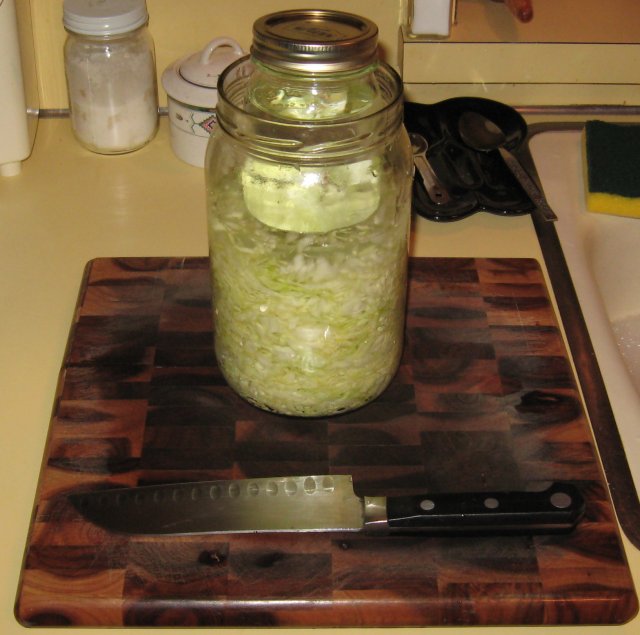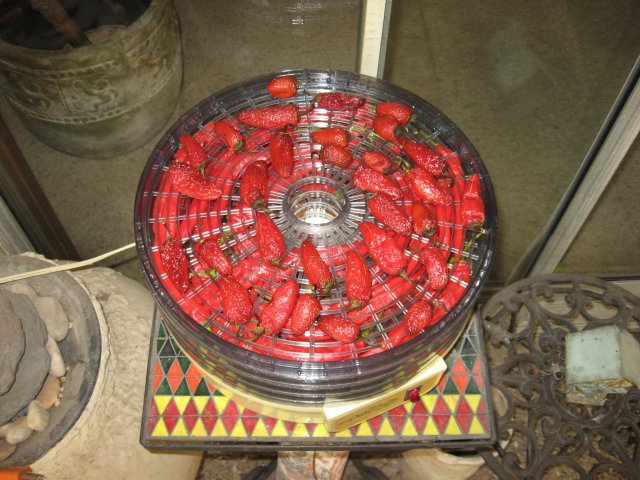Kimchi is somewhat analogous to Sauerkraut. It is the National Dish of Korea, and has spread across the world because of its awesome Hot and Sour taste. It is a fermented Cabbage, which is like old school pickling, before the Industrial Age. Traditional Sauering and Pickling techniques may not be as quick as modern sterilization techniques, but they are certainly better tasting, and way more nutritious. Making Kimchi is a process and once you know rules and procedures of the process it is not too difficult to make.

First of all there are no hard and fast rules, not even a specific recipe. The ingredients are open to interpretation, and many people make their own variations, based on their taste. Maybe the two things that really have to be there are Napa Cabbage and Sea Salt. This time I am going to add some diced Daikon Radish also. I had previously prepared some Brine, which is 4 cups of water, and 4 tablespoons of Sea Salt. Bring the water to a boil, add the salt and dissolve it all the way, then let the brine cool to room temperature.
I'm only going to add one Daikon, I'll peel it first, then dice it. There are many other vegetables that could possibly be used in a Kimchi. There are spices in Kimchi, but we will do that later.. First we need to brine the vegetables for 24 hours before we do the final assembly of the Kimchi.
The end of the Napa Cabbage will look like a flower when the process when it is done, so we don't want to toss it. Then I'll rough chop the rest of the Napa Cabbage, and Daikon Radish.
I am going to add some whole garlic as well, so we need to brine them along with the rest of the vegetables.
Next we'll put the chopped vegetables and and cooled brine into the jar, this one is two quarts.
Then we'll use another sterilized jar filled with water, which fits inside the other sterilized jar to hold the vegetables down during their soak in the brine. The vegetables will stay in the brine like this for 24 hours.
Now we are going to add the spices to the Kimchi. First we're going to drain the brine from the vegetables, and reserve it for later. Then we'll need a large mixing bowl to combine the vegetables with the Sambal, or the condiment (sauce). I am going to make Chile Garlic Sauce (Sambal) for our Kimchi.
Chile Garlic, hmmm, sounds like something I know a little about. These are the Cayenne Chiles from my mid-Summer Harvest. It's not precisely the right Chile, but they're pretty close. Kimchi would probably be made with something more akin to a Thai Chile. So I'll take 15 of these Cayenne Chiles and put them in a steamer for 15 minutes.
Rehydrating the Chiles will help them to integrate into the Kimchi faster. You can add dried Chiles to the Kimchi, or even Chile powder. Some people may want to use less Chile, for me its full tilt Cayenne.
The ingredients for the Sambal are 15 Cayenne Chiles, 15 Garlic cloves, a teaspoon of Sea Salt, and 2 tablespoons of Fish Sauce. The yield for a batch like this is about a quart of Kimchi, so there is a lot of Chile Garlic flavor relative to the amount of vegetables. So this one will be extra Hot and Garlicky.
Then we'll put the Sambal Ingredients in the food processor and turn it into a paste. A Hot and Garlicky paste.
Then we'll add the Sambal to the brined vegetables. You may want to put some Vinyl gloves on at this point. While the Cayenne Chile is not nearly the hottest Chile, a large concentration can irritate your skin.
Mix the Sambal, and the brined vegetables together thoroughly. You want to get some Sambal on every piece of Cabbage. Notice the Napa "Flower" in the middle there. I think that is my favorite part.
Finally we'll pack the Kimchi into a sterilized one quart jar. It really needs to be packed in there. This one had enough moisture because of the Fish Sauce, but if you need more liquid when packing the Kimchi add some more brine. After the jar is totally packed full I will use another lid, which fits inside the quart bottle, to hold the Kimchi down. The Kimchi needs to vent as it ferments so we want a liquid seal on top of it to let the Carbon Dioxide out, but prevent external air from getting in. There are many systems to do this, and what I am using is probably the most basic, an inverted lid filled with brine.

The Kimchi will need to ferment at room temperature for a week. During that time you will need to keep an eye on the top of the jar. The Kimchi needs to remain submerged beneath the brine/Sambal. You want to keep most of the liquid isolated from external air. You need to check and clean the lid at least once a day. Add brine if you need to bring the liquid level up. Once the fermentation has peaked then you can put the correct lid on the bottle, and store it in the refrigerator for Kimchi on demand. Mine doesn't last very long once its ready. I can eat a pint of Kimchi within a day, so a quart is only a two day supply.







































